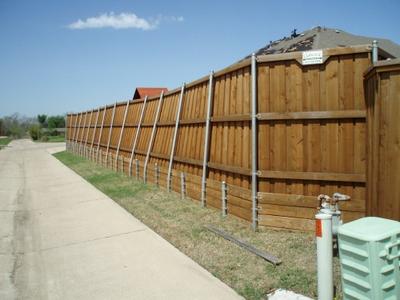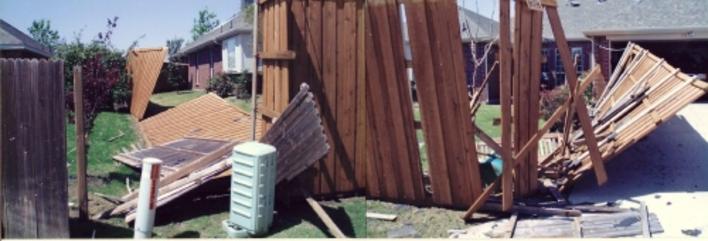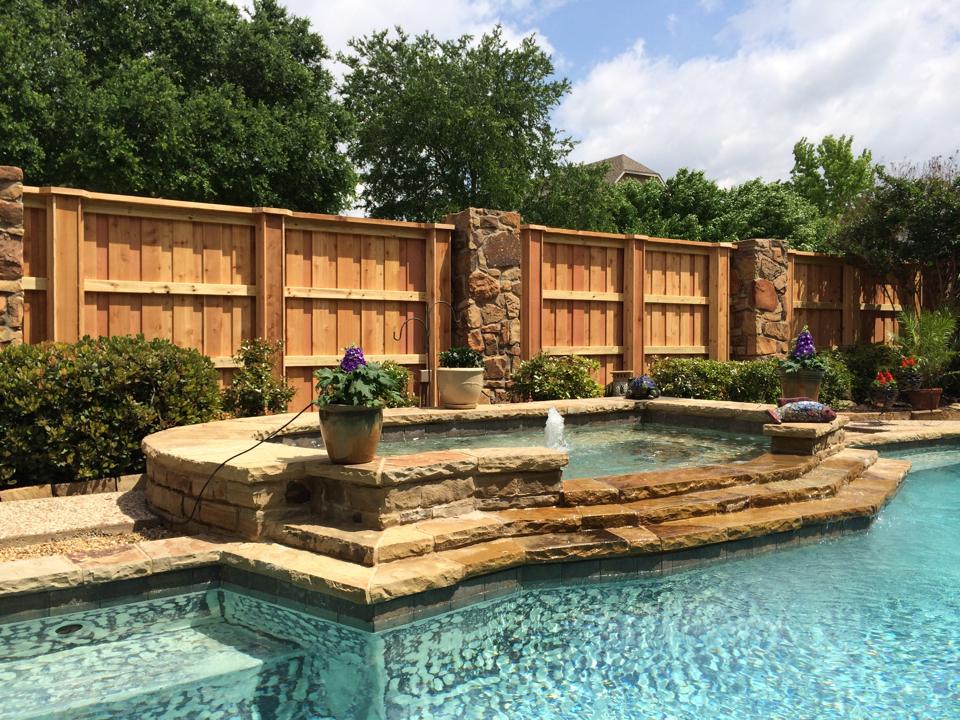How Hancock Fences Held Up to the Allen, TX Tornado in 2006
We have two fences that backed up to (what was an empty field at the time) the northwest corner of Alma & Exchange here in Allen. As best we can tell these two fences took a DIRECT HIT from the tornado because of their open location.
We use this term “Tornado” lightly as it took a while for the storm to finally be categorized as an F-1 tornado. An F-1 rating means that wind speeds were between 73 and 112 mph as rated on the Fujita Scale.
This rare and violent storm proved to be an incredible learning experience for us. Here is what we learned about our construction methods and materials and what we are doing differently now as a result.
Our Steel Posts

As you can clearly see above, our standard steel posts have bent at the base. We have always set our posts three feet deep and we have learned that this is a strong enough set depth. At this depth, the post itself will fail before the ground or concrete gives way. We saw many fences with the posts pulled out of the ground because they were not buried deep enough to support the fence. We now offer a thicker post upgrade that should add another 15 mph of wind resistance.
Our Quality Nails
Many people assume that nails are cheap and don’t really work well. We have been using only high quality, premium nails for years. We do not use generic brands or whatever is on sale to save a few bucks. This fence was built in October of 2005 with our standard nails. As you will see in this photo and the upcoming photos below, not one single board has blown off even though they are fastened the back side of the horizontal rails! This was a pleasant surprise and we will continue to use these nails. We now offer a washer-head screw upgrade for those who want maximum holding power… just in case.
Our 2X4 Rails

The “Rails” are the horizontal boards that you see connecting between the posts and are the framework of the fence. We have always “staggered the seams” on our rails knowing that this increases the overall strength of our fences. This means that the we try alter the locations where the rails butt together and not place them all on a single post. This fence is located next-door to the fence that is shown above this photo. As you can see this fence is built on a radius to follow the curve in the alley. Because of the curve, this design required the rails to be seamed at each post in order to make it round.
This causes a weak point at each post and the fence failed here in order to let the wind pass through. We now have a new design that will increase wind strength by a minimum of 50% on future curved fences.
Our Competition

The fence above was built by BEST FENCE. As you can see it is completely destroyed.
A Hancock Fence is located just to the right of the above photo (right next door) and is shown below. There is a seam in the center of the above photo to save space. This allows you to see the left and right side of their fence in one shot.
Now look below at our fence which is located on the other side of this driveway. This is a real example of the strength of our fences in a side-by-side comparison.

Builder Fences
As you can see below, the builders fences in this area didn’t stand a chance. Most were totally wiped out.
However, that is a Hancock Fence on the left side of the photo – still standing strong!

Vinyl Fence
We have always believed that vinyl fence just won’t perform well in our area. As a result, we do not offer it or build it. Our summers are too hot, our soil moves too much, and our storms are too numerous and violent. With it’s snap together design and its loose, shaky results, vinyl fences just won’t hold up when the going gets tough. As you can see here, this large, very expensive vinyl fence simply and completely blew apart.

We are glad it does not have our name on it. We actually bid this job 2 years ago.
We did not get it because we won’t install vinyl for the above reason.
Retaining Walls
Block retaining walls that also have to support a fence did not do well either. These wall systems are engineered from the top of the wall down. Anything above the wall puts additional stress on the wall system in which it was not engineered for. This is NOT our fence or wall. We did replace this fence and made several design changes to increase the strength of the wall and fence.

In Closing
Thank you for taking the time to read this page, we hope it was helpful to you.
We would like to extend our deepest gratitude to all of our customers who were patient and kind enough to wait for us to get them serviced. Many had to wait for months. We truly appreciate your business. We would also like to apologize to those we could not help or those who could not wait because of their situation. We certainly understand and wish we could have been more helpful in your time of need.
The tremendous damage caused by this storm was wide spread and could have been worse. We have been wanting to build this page for months but we have just been too busy. We (like many others ) were quickly overwhelmed by the demands this storm created. Four months later our work load is starting to return to normal and we have gained a wealth of knowledge.
Thanks you from all of us at Hancock Fence!

